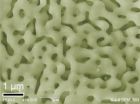(Press-News.org) EAST LANSING, Mich. --- Here's another reason to drop that doughnut and hit the treadmill: A new study suggests aerobic fitness affects long-term memory.
Michigan State University researchers tested 75 college students during a two-day period and found those who were less fit had a harder time retaining information.
"The findings show that lower-fit individuals lose more memory across time," said Kimberly Fenn, study co-author and assistant professor of psychology.
The study, which appears online in the research journal Cognitive, Affective & Behavioral Neuroscience, is one of the first to investigate young, supposedly healthy adults. Previous research on fitness and memory has focused largely on children, whose brains are still developing, and the elderly, whose memories are declining.
Participants studied related word pairs such as "camp" and "trail." The next day, they were tested on the word pairs to evaluate long-term memory retention. Long-term memory is anything remembered more than about 30 seconds ago.
Aerobic fitness was gauged by oxygen consumption derived from a treadmill test and factored with the participants' weight, percent body fat, age and sex.
The findings speak to the increasingly sedentary lifestyles found in the United States and other Western cultures. A surprising number of the college students in the study were significantly out of shape and did much worse at retaining information than those who were extremely fit, Fenn said.
INFORMATION:
Her co-authors included kinesiology researchers Matthew Pontifex and Karin Pfeiffer.
Out of shape? Your memory may suffer
2014-05-02
ELSE PRESS RELEASES FROM THIS DATE:
A 30-year puzzle in breast cancer is solved
2014-05-02
In a new study published today in Cell Reports, scientists at the Fred Hutchinson Cancer Research Center demonstrate that mice lacking one copy of a gene called CTCF have abnormal DNA methylation and are markedly predisposed to cancer. CTCF is a very well-studied DNA binding protein that exerts a major influence on the architecture of the human genome, but had not been previously linked to cancer. Over 30 years ago, frequent loss of one copy of chromosome 16 was first reported in breast cancer but the gene or genes responsible remained to be identified. Dr. Gala Filippova, ...
Autoimmune diseases may succumb to new drug strategy
2014-05-02
New pharmaceuticals to fight autoimmune diseases, such as multiple sclerosis, rheumatoid arthritis and psoriasis, may be identified more effectively by adding genome analysis to standard drug screening, according to a new study by a research team led by UC San Francisco and Harvard researchers, in collaboration with Tempero and GlaxoSmithKlein.
In a study reported online April 17, 2014 in the journal Immunity, the scientists combined drug screening with state-of-the-art techniques for analyzing the genome, leading to three small molecules that improved symptoms in a mouse ...
Maternal deaths on the rise in the United States
2014-05-02
SEATTLE — The United States is among just eight countries in the world to experience an increase in maternal mortality since 2003 – joining Afghanistan and countries in Africa and Central America, according to a new study by the Institute for Health Metrics and Evaluation (IHME) at the University of Washington.
The study, "Global, regional, and national levels and causes of maternal mortality during 1990-2013: a systematic analysis for the Global Burden of Disease Study 2013," published May 2 in The Lancet, ranked the United States number 60 in the list of 180 countries ...
Sharp decline in maternal and child deaths globally, new data show
2014-05-02
SEATTLE — Since the start of an international effort to address maternal and child mortality, millions of lives have been saved globally, two new studies by the Institute for Health Metrics and Evaluation (IHME) at the University of Washington show.
In 2000, the Millennium Development Goals (MDGs) were established by the United Nations to drive maternal and child deaths down by 2015. Child and maternal deaths had been falling in most countries since the 1980s, but the pace accelerated after the goals were set. If countries continue on this course, child deaths will fall ...
High quality 3-dimensional nanoporous graphene
2014-05-02
Sendai, Japan -- Three-dimentional (3D) nanoporous graphene with preserved 2D Dirac electronic characters was successfully synthesized by Dr. Yoshikazu Ito and Prof. Mingwei CHEN at Advanced Institute for Materials Research (AIMR), Tohoku University. The nanoporous graphene is constructed by a single layer graphene sheet that is continuously inter-connected to form a complex 3D network structure. This free-standing nanoporous graphene with an excellent crystallinity possesses high mobility, holding great promise for the applications in electronic devices.
The nanoporous ...
New atom-scale knowledge on the function of biological photosensors
2014-05-02
The research groups of Janne Ihalainen (University of Jyväskylä) and Sebastian Westenhoff (University of Gothenburg) have clarified how the atom structure of bacterial red light photosensors changes when sensing light. The research reveals structural changes in phytochrome protein when illuminated.
"The results are a unique demonstration of proteins' ability to structural changes in different phases of their operation. This helps to understand how the biological photosensors function. The modelling and utilisation of protein for other applications becomes much easier ...
Small variations in genetic code can team up to have a bi
2014-05-02
Scientists at USC have definitively demonstrated that large sets of variations in the genetic code that do not individually appear to have much effect can collectively produce significant changes in an organism's physical characteristics.
Studying the budding yeast Saccharomyces cerevisiae, USC's Matthew B. Taylor and Ian M. Ehrenreich found that the effects of these genetic variants can depend on four or more other variants in an individual's genome.
Most genetic analyses of heritable physical characteristics, including genome-wide association studies in human populations, ...
New myeloma-obesity research shows drugs can team with body's defenses
2014-05-02
Obesity increases the risk of myeloma, a cancer of plasma cells that accumulate inside the bones.
And with current obesity trends in the United States and especially in South Texas, that's ominous.
"I'm predicting an increase in multiple myeloma," said Edward Medina, M.D., Ph.D., "and with the obesity problems we see in the Hispanic population, there could be a serious health disparity on the horizon."
Dr. Medina, a hematopathologist and assistant professor in the Department of Pathology at The University of Texas Health Science Center at San Antonio, is looking ...
AGA unveils latest advances in GI research at DDW 2014
2014-05-02
Chicago, IL (May 2, 2014) — International leaders in the fields of gastroenterology and hepatology will gather together for Digestive Disease Week® (DDW) 2014, the largest and most prestigious gastroenterology meeting, from May 3 to 6, 2014, at McCormick Place in Chicago, IL. DDW is jointly sponsored by the American Gastroenterological Association (AGA) Institute, the American Association for the Study of Liver Diseases (AASLD), the American Society for Gastrointestinal Endoscopy (ASGE) and the Society for Surgery of the Alimentary Tract (SSAT).
AGA researchers will present ...
Nature's chemical diversity reflected in Swedish lakes
2014-05-02
It's not only the biology of lakes that varies with the climate and other environmental factors, it's also their chemistry. More knowledge about this is needed to understand the ecology of lakes and their role in the carbon cycle and the climate. Today an international research group led by Uppsala University is publishing a comprehensive study of the composition of organic compounds in the prestigious journal Nature Communications.
- Lake water is like a very thin broth with several thousand ingredients in the recipe, all with different properties. At the same time ...



